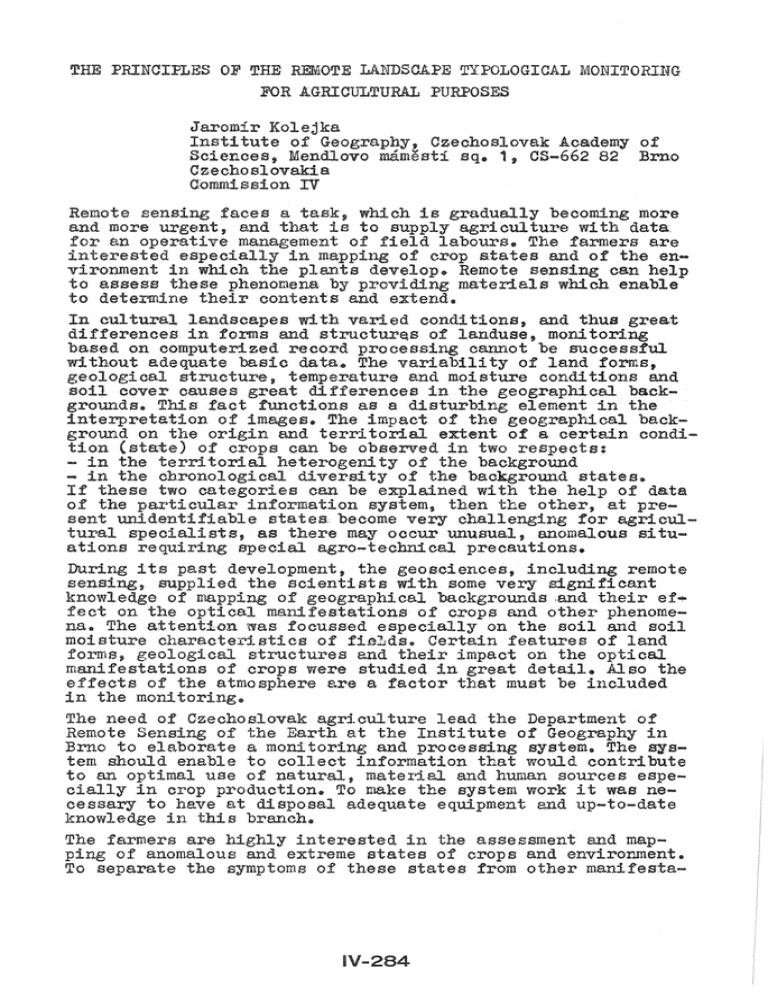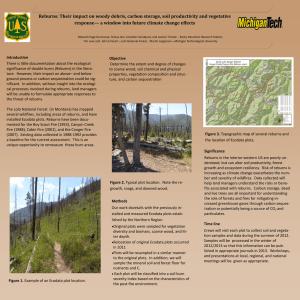MONITORInG Brno th the en-
advertisement

MONITORInG of Brno becoming more wi th data. farmers are the encan help enable and thuB monitoring successful geosciences, s with some land cal • so the included the Department of Institute of Geography in ceasing system. The SJsthat would contribute and hunlan sources espework it was neThe farmers ping of To assessment and maps environment. from 0 man! tions. of the studied objects, it was necessary to propose a cal data base that would prefer to identify such states and would lower the level of noise. The RELATYMOS programme = Remote Landscape Typological Monitoring System) is designed the above mentioned purpose and helps to improve the thematic interpretation of remotely sensed records, but it cannot provide a thorough and completely reliable interpretation of imeges for the almost unlimited number of variations of impact factors. secondary situations that could in vi sual and GEOECOLOGICAL LOCATIOn the studied phenomena. Farmland and other areas on the Earth a surface and phenomena in the atmosphere are affected others, by their geographi backgrounds, i.e. by actions with those natural factors of the terri tory which for. . . the landscape structure of the particular region. geographi is formed by a network of units. These taxonomical ranks of s. repetitionsl to cation features a parti elementary geodata the basic parameters of the innatural components: geology, relief, topoclimate, moisconditions, type and art soil, vegetation association, c. This information can be obtained both from partial maps and from remote sensing. Their integration can be performed with the help manual and computer processing. Without any regard to the applied procedure, the result of the synthesis is a geoecological map of landscape. The individual units - geocomplexes are described by defining parameters which are in mutual harmony. The map then represents a kind of base for cal information system ( )• network s the studied areas to remotely sensed and monito, must be well corrected vdth of suitable and satellite images. Different ways cultivation can cause small chan8es of the un1 t contours of the lowest taxonomic s (Schroder, 1984). The background, differentiated geoecologically, reflects in the states of crops. In a territory with varied natural conditions and comparatively large plots (fields), as the case of Czechoslovakia is, it is quite common to find one plot situa.... ted on several different geocomplexes. Then the territorial optical manifestations of one kind of crops in one ii d will correspond with the territorial differentiation of the background. This fact can be caused be different soil cover, wettness, parent substrate and landforms. The opti di s 1. j s phenophase or permanently. between soil and optical ma~ t to long-term investigations. s (Sagdeyev, Salishchev, Kautzle.,... _, 1982; , Tinney, Jackson, 1984; 0 Ne~l et al., Elridge, Lyon, 1985; Buete, Jackson, st, 1985; Schneiselmayer, Plank, 1987) show that under certain conditions the character of soil cover - especially the colour (de, on moisture and properties the ins uffilally in cases completely (up to 10 bare soil, up to • other cases (e. fferentiating also in areas with usuall~ affects the reliability interpretation indirectly through other geocompoedges and slope declination in the soil above sea level the topoclimate; all the phenophases. The terrain exposition supply evaporation and possi overshadowing). Wi the exception of etion time recording, s of the environ, featu .... cs can maps of landscape. by its structure but also by the staThe complex geoecological information enables to deduce some seasonal stages of geocomplexes (higher soil moisture, manifestations of the parent material of soil in the periods of precipitation defioiot, differences in the humus contents due to soil type and mode of soil cultivation, etc.) and then to consider certain aspects of the inner heterogenity of plots as natural and therefore harmless. In other heterogenous phenomena which cannot supported by a territorially differentiated geoecological information, the possibilities of identification, mapand interpretation become the object of investigation. There is a choice of procedures available for compiling geo .... ecological maps. The Institute of Geography in Brno applied method of overlay and integration of geocomponenta.l maps both mechanically and automatically using multivariation stati os. The starting scale is 1:25 000. These maps are expected to used effectively up the scale of 1:250 000. Up to now two basic forms of map and image data integrating have been performed: anad:litive synthesis of a contour map and a multispeotral image, a digital integration of a digitized areal landscape map jdigitized by a scanner with resolution similar to resolution digita.l image datal with a digital image. Additive syntheses of multispectral images with contour maps oonsiderably improve t.he visual interpretation of the records (e.g. on the monitor of used NAC 4200 F system)~ Additive di ..... II', .. gital information allows a bing the image pixel. This plies both controll and 2. The principle imminent LOCATION died objects and phenomena. The previousJ.y mentioned Ie shows that every studied object can be the of local features of the environment. The cal looation is with the of the obje whi pographic map uEted. ritory by the actual conditions verst.1.S insolation, an The knowledge of les to perform multitemporal conditions photography. stu- The location of en object in map related to its ons of photogra.phing. their sition both to the mined by relief. information COJ~CE~r.r~D~ and the position coordinates). s shadowing on a digital the DTM formation solution of the record draw information from works of the DIBAG Institute in Graz, Austria (Diarra, 1982) and make use of experience gained ecological studies (Tom, Miller, 1980, Ststanovic, Wiersema, 1985; Jones J Wyatt, Settle, B,o binson, 1987). In spite the fact that there ex! a number of transitions between dowed and insolated areas, the data. is divided, sake simplicity, only two • These are processed separately by the same method the results are then again integrated into one image. As the ggricul tural plots usually have the slope declination up to 15 (cultivable common agricultural machinery), is not neoessary to consider the deforming effects of insolation on the studied crops - it follows from the reoords from the time around midday in the vegetation period (Hall-Konyves, 1985). When analysing the plots on steeper slopes the knowledge of real overshadowing is inevitable. The data on terrain overshadowing are the output for the RELATYMOS programme. Other derived data on the relief oan be used for stUdies of other types (study of the regularity in the ocourence of certain phenomena) • .3. The priciple of INFOmf!ATION LOCJJ.TIOI'l BY' AGRICULTURAL LJ\..ND PARCELS. 'F;t.,rery ace lend under ds, or- • In re- geograpa combi- s are not values of the neighbouring Plank 1987). border can away in adindicaed, border mixel sis the ap . . . computing. a short back, method emphasisses the borders plots momentarily. multitemporal studies, standard optical fea.(although fferent natural ), it is to know border . . . . . . . . . ~J'..., the of pI s is .. The over more vegetation ). March 1988, the Institute of Geography a study to the variability of shapes acreage of the ots (as from the saimages) two training areas with different natural . . . . . . . .,........... We found that about .~~ of the plots fiat ter.... rain and,61 % dissected terrain change repeatedly. In the ten year s period, 1977 . . . 1987 (4 satellite images), only 1/3, or 1/5 of the total number of plots remained unchanged. When collecting data on plot parcelling a chosen area it is necessary to perform corrections and bring the map up-to-date digitizing the networke Multispectral comparisons can use a ctitious network smaller areas with a denser border a.l1 the the standard of optical images, a set of 5 recor~s different ent. There is a • The sum ceed 5 % of all maps, of of pe,r'cels crops a mosaic homogenous areas work of This mosaic is by a satellite image. optimal processing it all the material s in a. digital form with a fied rea~lution. The error in the overlay must llot exceed 1/2 pixel (x ~ 0,51 Y ± 0,5). The overlain information is expressed by the vecter x,y) == (z . ), where' i '...... the number variables (e.g. in a geoecol~gical map: parent material .... Ztt land form .... z2' topoclimate - Zj' character of moiture conditions .... z 4' so:r:l type .... z~, ••• ; in DTM: overshadow/insole,tion .... Zh; ~he parcel map: address the p~rcode - z , parcel pixel .... Z , orop .... phenophase .... z ; in th~ multispectral image: by ~he number sensored ted areas nophases ban!Q,eto. This complex information can to controlled or uncontrolled classifi submitted either 'the i:nforma,tion on parcel address is not concerned). The combination t its parameters, and the IB~test parameters the environment correspond \dth the intervals of optical classes in the individual bands record. resul ts of the statistical pX 0cesSing can be reproduced cartographically (parts of the s in homogenous conditions can be "allotted" of densi ty ) and the can compared with the original e up pixels with signifi the standard (? anomalies 1). 4 geographical background and anthropogenous activicult problem. Certain progress has been in by a J a analogous es. The anomalies can a multispectral by introduci.ng standard into a homogenous area (homogenous as to the geographibackground, and crop phenopha,se). thi sway we form a fictitious image of crop states in the defined conditions identify the differences between supposed and actuoptical manifestations the registered areas. Comparing the fictitious image and the corrected new image can help to identify the anomalies find their cations, anaJ.yse their manifestations t etc. The image pixels found in anomalous areas represent a suocessive data set, analysis of which can contribute to the assessment of: geographical background, insolaplant cover and its phenophase, and type of anomaly. At sent there is no available survey of significant factors affecting the optical mani stations of crops under certain condition, neither is there a list of methods of their quanti . . . cation in remotely sensed data. is necessary therefore, base the procedure on available gre,phical and interaction , although trds means to process great amounts of information. Gradual integration of data can be solved in harmony with the possibilities of computers. The present of the RELATYMOS programme is concentrated on the i cation and location of OUB states in crops. Only further it be po e to specify, both theo . . . retically and , the variants of the RELATYMOS programme the identi and mapping various anomalous phenomena in the caused by p s, saes, erosion, v~._ _ ~~ c pro were problem also REFERENCES ALLAN J.A. Crops: Advances pp. 1. BERUCHASHVILI scej DIARRA G. tem De ELVIDGE C.D •• LYON Variation on Sensing of EZRA C.E., TINNEY L. Background on Remo:'ie Sensing ID.LL-KONYVES K. 0 (1985): Topography upon ~~~~~.~~ ting Terrain. 1-50. HUETE ,JACKSON of a Plant Canopy Sensing of "t"'O""''''''Irn,,,.'V'> JONES a DTM HRV Data Advances in Digital yPP_ 488-497. ONEILL P.E. et .(1984): s and Water Content on Microwa~e ture. Remote Sensing of Environment 16:1: SAGDEYEV R.Z. J S.ALISHCHEV ., KAUTZLEBEN, • (1982): Desifrirovanije mnogozonalnych kosmiceskich snimkov. Moskva, 83 p. 1 SCHNEIDER W., HEISELMAYER ,PLANK (1987): Use Mapping in with SPOT. Manuscript of Vienna, 12 p. , WIERS~~ G. (1985): from digital emodels mountain habi Journal 3:177 86. SCHR~DER H. (19842= Musterauspraguns und spektr~es Abbildungsverhalten von Lo3boden im ~uttelsachsischen Hugellend. Geograprdsche Berichte 112:3:185-196. TOM G.H., MILLER L.D. (1980): Forest Site Index Mapping and Photogrammetric Sensing 6.






